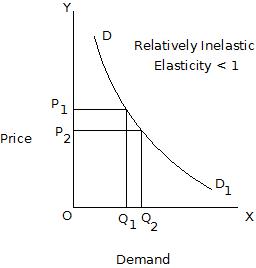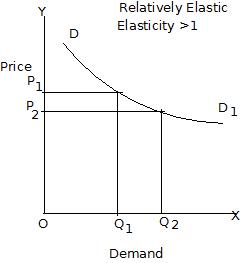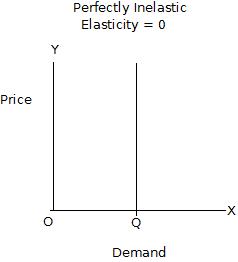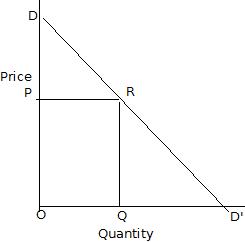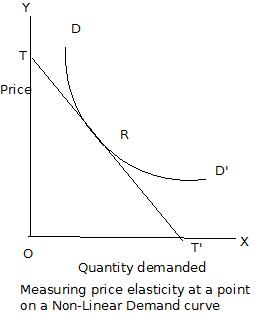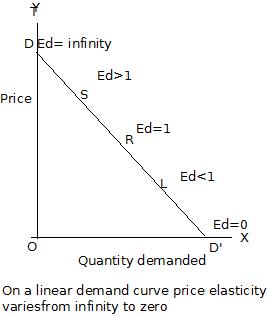Elasticity of Demand
MICROECONOMICS

|
Introduction |
{{{2}}}
In the earlier discussion we were able to understand the relationship between demand and price. Recapitulating the discussion briefly, The Law of Demand states that “Other things remaining the same the demand for a commodity increases when its price falls and it decreases when its price increases".Thus according to the law of demand there is an inverse relationship between price and quantity demanded, other things remaining the same. These other things which are assumed to be constant are taste or preference of the consumer, income of the consumer, prices of related goods etc .If these factors undergo a change, then the inverse relationship may not hold good. However we also observe that for commodities like salt or rice we do not notice much of a change in demand whereas in case of goods like Air conditioners, Cars etc even with a small change there is substantial increase in demand. The Law of demand while stating the relationship between demand and price mentions only the direction of change in demand but does not mention anything about the magnitude of the change which is very essential in decision making process for the producer and Government.For example:
"If I lower the price of my product, will the sale increase?"
"If I raise the price, will it affect my profit?"
“If sales tax rate is increased will it have an effect on the revenue collection?"
are questions that need to be answered.
This information as to how much or to what extent the quantity demanded of a good will change as a result of a change in its price is provided by the concept of Elasticity of Demand.
| Definition |
Elasticity of Demand refers to the degree of responsiveness of quantity demanded to the changes in the determinants of demand .
There are mainly three quantifiable determinants of demand:-
- Price of the Good
- Income of the Consumer
- Price of the Related Goods
Types of Elasticity Of Demand
As we have seen above there are three quantifiable determinants of demand, Hence elasticity of demand can be of three types
- Price Elasticity of Demand
- Income Elasticity of Demand
- Cross Elasticity of Demand
| Price elasticity of Demand |
Concept Of Elasticity of demand Alfred Marshall introduced the concept of elasticity in 1890 to measure the magnitude of percentage change in the quantity demanded of a commodity to a certain percentage change in its price or the income of the buyer or in the prices of related goods .In this section we look at the sensitivity of demand for a product to a change inthe product's own price.Since Price Elasticity of Demand is predominantly used in economic analysis it is alternatively referred to as Elasticity of Demand.
Definition
Price Elasticity of demand is the degree of responsiveness of demand to a change in its price.In technical terms it is the ratio of the percentage change in demand to the percentage change in price.
Thus,
Ep = Pecentage change in quantity demanded/Percentage change in price
In mathematical terms it can be represented as: Ep =(∆q/∆p) (p/q)
From the definition it follows that
- when percentage change in quantity demanded is greater than the percentage change in price then, price elasticity will be greater than one and in this case demand is said to be elastic.
- when percentage change in quantity demanded is less than the percentage change in price then, price elasticity will be less than one and in this case demand is said to be inelastic.
- when percentage change in quantity demanded is equal to the percentage change in price then price elasticity will be equal to one and in this case demand is said to be unit elastic.
| Numerical example |
To calculate price elasticity of demand:
Let us consider a situation where Price of tea has increased from Rs.7 to Rs 8and as a result of this demand for tea has declined from 50 cups to 48 cups.
The price elasticity in this case can be calculated as follows:
Percentage change in demand = ( New demand – Old demand)/Old demand
= (48-50)/50
= -0.04
Percentage change in price = (New price –Old Price)/ Old price
= ( 8- 7)/ 7
= o.14
Price elasticity of demand = (percentage change in demand)/(Percentage change in price)
= - 0.04 /0.14
= -0.28
Since the Elasticity of Demand is less than one Demand is inelastic . In other words we can say that for a 14% increase in price ,demand has declined only by 4% . The negative sign indicates the inverse relationship between demand and price.
| Diagrammatic representation Of Price Elasticity Of Demand |
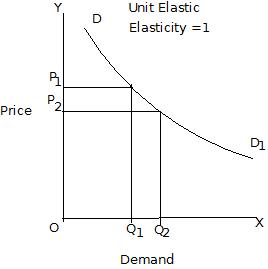
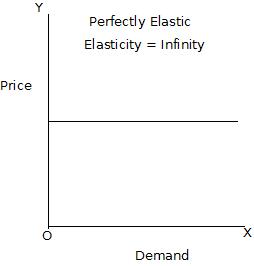
| Determinants Of Price Elasticity Of Demand |
There are number of factors which determine the price elasticity of demand. Let us consider some of these factors.
Firstly if close substitutes are available then there is a tendency to shift from one product to another when the price increases and demand is said to be elastic. For example, demand for two brands of tea. If the price of one brand A increases then the demand for the other brand B increases. In other words greater the possibility of substitution greater the elasticity.
Secondly how much of the income is spent on a commodity by the consumer. Greater the proportion of income spent on the commodity greater will be the elasticity.
Thirdly the number of uses to which the commodity can be put is important factor determining elasticity. If the commodity can be put to many uses then the elasticity will be greater.
Fourthly if two commodities are consumed jointly then increase in the price of one will reduce the demand for both.
Fifthly time element has an important role to play in determining the elasticity of demand . Demand is more elastic if time involved is long. In the short run , it is difficult to substitute one commodity for another.
Sixthly Cost of switching between different products and services.There may be significant transaction costs involved in switching.In this case demand tends to be relatively inelastic.For example ,mobile phone service providers may include penalty clauses in their contracts.
Seventhly Who makes the payment, Where the purchaserdoes not directlypay for the goodthey consume, such as perks enjoyed by employees,demand is likely to be more inelastic.
Finally Brand Loyalty,An attachment to a certain brand either out of tradition or because of propriety barriers can override sensitivity to price changes, resulting in more inelastic demand.
| Measurement of Elasticity of Demand |
i. Percentage Method .
i. Point Elasticity Method.
ii. Total Outlay Method.
iii. Arc Elasticity.
Let us discuss each of these measures in detail.
| Percentage Method |
Price elasticity can be measured by dividing the percentage change in quantity demanded in response to a small change in price ,by the percentage change in price.
The definition and the numerical example disussed earlier explains the percentage method. Mathematically , price elasticity of demand ha s a negative sign since the change in quantity demanded is in opposite direction to the change in its price.Only goods which do not confirm to the Law of Demand like Veblen good or Giffen good have positive price elasticity of demand.Hence for sake of convenience in understanding the magnitude of response of quantity demanded of a good to a change in its price we ignore the negative sign and take into account only the numerical value of the elasticity.The accuracy of the percentage method is questioned on the ground that the value of the elasticity depends on which value is taken as the starting point in the calculation of percentage.
For example, if quantity demanded increases from 10 units to 15 units, the percentage change is 50%, i.e., (15 − 10) ÷ 10 (converted to a percentage). But if quantity demanded decreases from 15 units to 10 units, the percentage change is −33.3%, i.e., (15 − 10) ÷ 15.Two alternative measures avoid or minimise the shortcoming of the percentage method. Now we proceed to understand the Point elasticity method.
| Point Elasticity Method |
Measuring Elasticity Of Demand on a Linear demand Curve
Let a straight line demand curve DD’ be given and we have to measure price elasticity of demand at the point R on this demand curve.
The measure of price elasticity of demand is given by :
Ep =(∆q/∆p) (p/q)
The first term in this formula ,(∆q/∆p) is the reciprocal of the slope of the demand curve DD’(slope of the demand curve is equal to Change in price divided by change in quantity demanded and will be the same all along the straight line demand curve). The second term is the original price divided by the Original Quantity. Thus
Ep =(1/slope)(p/q)
Now at point R in the diagram, Original price p = OP and Original quantity q = OQ.
Further ,slope of the demand curve DD’ is ∆p/∆q = PD/PR
Substituting these in the above formula we have
Ep =[ 1/(PD/PR)](OP/OQ) = (PR/PD)(OP/OQ)
However PR =OQ and they will get cancelled and therefore
Ep = OP/PD
This represents the ratio of the distances on the vertical axis.
In a right angled triangle ODD’,PR is parallel to OD’.
Therefore
Ep = OP/PD =RD’/RD
RD’ is the lower segment of the demand curve DD’ at point R and RD is its upper segment.
Therefore,
Ep = RD’/RD =Lower segment/Upper segment.
Measuring Price elasticity on a non –linear demand curve.
In order to measure elasticity in case of a non linear curve we draw a tangent at the given point R on the demand curve DD’ and then measure price elasticity by finding out the value of RT’/RT.
On a Linear Demand curve price elasticity varies from Zero to infinity. This can be represented diagrammatically as follows.In this diagram elasticity is being calculated at five points D,S,R,Land D'.
| Total Outlay Method |
From the changes in the total expenditure made as a result of changes in its price ,we can know the price elasticity of demand for the good. However it should be taken note that it is possible to identify whether price elasticity of demand will be greater than one, less than one or equal to one only. The exact or accurate price elasticity of demand cannot be found. Let us under the relationship precisely.
Unit Elasticity: With a change in the price of the good, quantity demanded increases, the total expenditure remaining the same, elasticity of demand is equal to one. The reason for this is ,if total outlay has to be the same then the percentage change in price has to be equal to percentage change in quantity demanded.
Elasticity greater than one: With a decline in the price of the good, quantity demanded increases, the total expenditure also increases, elasticity of demand is greater than one. The reason for this is ,if total outlay has to increase then the percentage change in quantity demand has to be greater than percentage change in price. Similarly due to an increase in the price of a good if there is a fall in the demand and as a result there is a decline in the total expenditure then also the elasticity of demand is greater than one.
Elasticity Less than one : With a decline in the price of the good, quantity demanded decrease, the total expenditure also decreases, elasticity of demand is less than one. The reason for this is ,if total outlay has to decreases then the percentage change in quantity demand has to be less than percentage change in price. Similarly due to an increase in the price of a good if there is an increase in the demand and as a result there is a increase in the total expenditure then also the elasticity of demand is less than one.
Let us understand this method with the help of an illustration.
The table given below gives data on the price per unit of pen, the quantity demanded at different price levels , the resultant expenditure and the elasticity of demand under different situations.
| Price of pen in (Rs) P1 | Quantity demanded Q1 | Total expenditure R=P1*Q1 | Elasticity of Demand |
| 5.00 | 30 | 150 | |
| 4.75 | 40 | 190 | Greater than one |
| 4.50 | 50 | 225 | Greater than one |
| 4.25 | 60 | 255 | Greater than one |
| 4.00 | 75 | 300 | Greater than one |
| 3.75 | 80 | 300 | Equal to one |
| 3.50 | 84 | 294 | Less than one |
| 3.25 | 87 | 282.75 | Less than one |
| 3.00 | 89 | 267 | Less than one |
| Arc Elasticity Method |
Arc Elasticity of demand
When price changes are large or we have to measure elasticity over an arc of the demand curve rather than at a specific point on the demand curve, the point elasticity method does not provide a true or correct measure of price elasticity of demand . Further, in such cases, the elasticity would be different depending on whether we choose original price and original demand or the subsequent price and quantity demanded as the basis for measurement of elasticity of demand. The outcome would be different under the two situation . Hence , when the change in price is quite large then accurate measure of price elasticity can be obtained by taking the average of original price and new price as well as average of the old quantity and new quantity as the basis of measurement of percentage changes in price and quantity. Thus if the price of a good declines from p1 to p2 and as a result the quantity demanded increases from q1 to q2 the average of the two prices is given by (p1+p2)/2 and
Average of the two quantities is given by (q1+q2)/2 . Thus the formula for measuring Arc elasticity
Is given by
E p = {∆q/(p1+p2)/2} /{∆p/(q1+q2)/2}
= { ∆q/(q1+q2)} {∆p/(p1+p2)}
= ( ∆q/∆p) {(p1+p2)/(q1+q2)}

|
Key Terms | ||
{{{9}}}
|
|||




